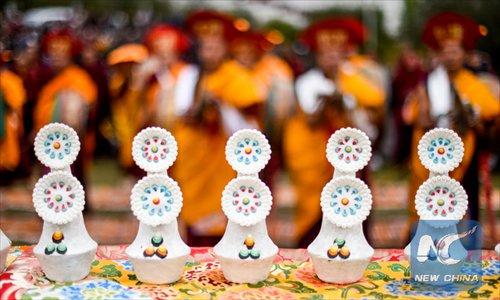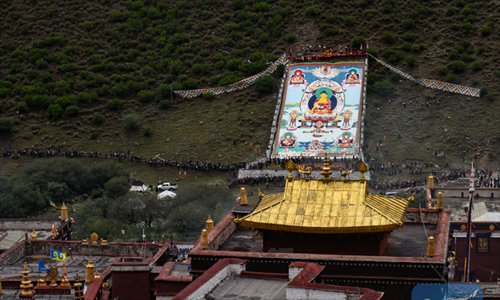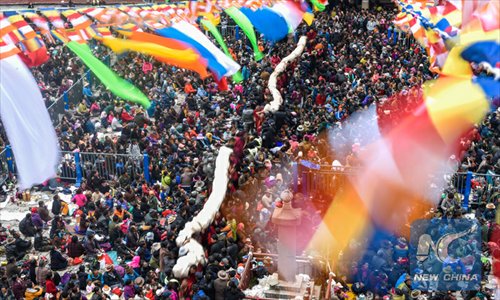Grand Ceremonies for Tibet's Saga Dawa

Tibetan butter sculptures at a Thangka worship event at the Tsurpu Monastery near Lhasa, capital of southwest China's Tibet Autonomous Region, June 16, 2016. (Xinhua/Purbu Tashi)

Monks and Buddhism followers attend the ceremonial raising of a huge prayer pole in the Tsurpu Monastery near Lhasa, capital of southwest China's Tibet Autonomous Region, June 12, 2016. (Xinhua/Purbu Tashi)

A huge Thangka of Sakyamuni, measuring 35-meter-wide and 38-meter-long was unveiled and hung on a mountainside near the Tsurpu Monastery on June 16. (Xinhua/Purbu Tashi)

Monks and Buddhism followers attend a Thangka worship event in the Tsurpu Monastery near Lhasa, capital of southwest China's Tibet Autonomous Region, June 16, 2016. (Xinhua/Purbu Tashi)

Monks and hundreds of Buddhism believers carry a huge scrolled thangka with the image of Sakyamuni, walking through the crowd at the Tsurpu Monastery on June 16. (Xinhua/Purbu Tashi).

A huge Thangka of Sakyamuni, measuring 35-meter-wide and 38-meter-long was unveiled and hung on a mountainside near the Tsurpu Monastery on June 16. (Xinhua/Chogo)
Every year around Saga Dawa, temples and monasteries across the Tibetan Plateau hold religious ceremonies and celebrations.
Among the most famous is the Tsurpu Monastery, seat of the Karma branch of the Kagyu order of Tibetan Buddhism and the place where the reincarnation ritual originated in the 13th Century.
Falling on the 15th day of the fourth month of the Tibetan lunar calendar, Saga Dawa marks three important events in the life of Sakyamuni, founder of Buddhism: his birth, enlightenment and attaining nirvana.
On June 12, thousands of believers, many coming from hundreds of miles away, gathered at the Tsurpu Monastery, around 70 kilometers west of Lhasa, capital of Tibet, to participate in the ceremonial raising of a huge prayer pole strung with prayer flags.
With auspicious prayers and mantras written on the flags, Tibetans believe the wind that blows through them can bring blessings and goodwill into all pervading space and carry benefit to all.
Unveiling a thangka, a Tibetan Buddhist painting on cotton or silk, is another important ritual at the Tsurpu Monastery that goes back more than 500 years.
In the early morning of June 16, thousands of pilgrims arrived at the monastery.
Excitement built as 30 monks clad in maroon robes walked solemnly out of the monastery to the beat of drum, followed by hundreds of believers carrying a huge scrolled thangka with the image of Sakyamuni.
As the monks chanted sutras and blew horns, the thangka, covering more than 100 square meters, was unveiled and hung on a mountainside nearby.
Believers put their palms together devoutly, worshiping the Buddha by prostrating themselves and reciting long prayers.